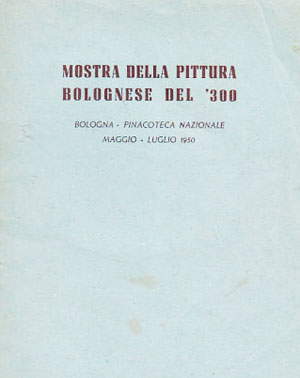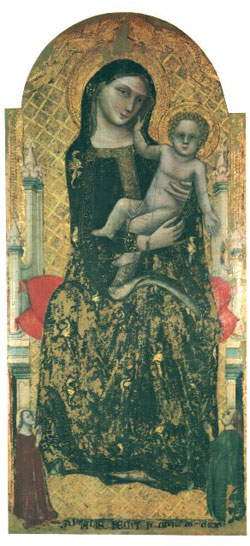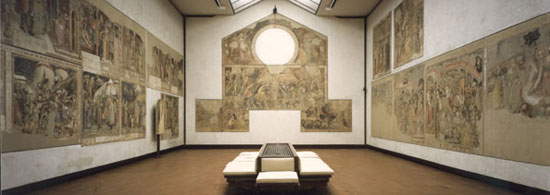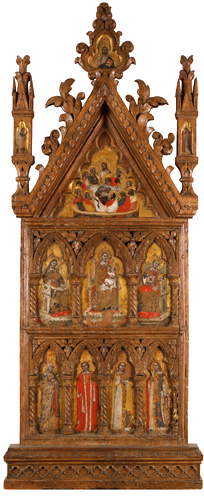In conjunction with the exhibition Da Cimabue a Morandi, which, as you know by now, opened to the public this Saturday, we want to devote a small series of three posts, here on Finestre sull’Arte, to the great Bolognese exhibitions of the past, in order to understand how the city of Bologna and the excellent art historians who lived or worked in Emilia (from Longhi to Emiliani via Gnudi and Arcangeli) contributed to the development of the discipline of art history in Italy. We begin today with the first exhibition we discuss, the one in 1950 devoted to the Bolognese Trecento: Exhibition of Bolognese Painting of the Fourteenth Century, edited by Roberto Longhi.
 |
| Catalog of the Exhibition of Bolognese Painting of the Fourteenth Century. |
Bologna, in particular, experienced the co-presence of important personalities in the history of art: suffice it to say that, in 1948, the Exhibition celebrating Giuseppe Maria Crespi was curated by Cesare Gnudi and Francesco Arcangeli together, with the collaboration of Roberto Longhi, who was in charge of the introductory essay in the catalog, but was also involved in the organization. Good: Longhi became the protagonist, two years later, of the exhibition on 14th-century Bolognese painting.
 |
| Vitale da Bologna, Madonna of the Teeth (1345; Bologna, Davia Bargellini Museum). |
There was also another need at the time, in addition to that of rediscovering a shared cultural identity. The war had produced extensive damage to ancient buildings, and many artistic testimonies of our past were under very serious risk. One of the first merits of the Exhibition of Fourteenth-Century Bolognese Painting consisted precisely in managing to save many of these endangered works of art. The exhibition had already been planned for some years: several churches, in the Bolognese area, had suffered collapse and structural damage during the war, and thanks to the work put together for this exhibition (which was strongly desired by the Bolognese Soprintendenza, which organized it together with theFrancesco Francia Association) it was possible to recover many works of art that probably, without such work, we would have lost or would have been irreparably compromised. One of the greatest achievements of Roberto Longhi and his exhibition was the transport, to the rooms of the Pinacoteca Nazionale in Bologna, where the exhibition took place, of the Mezzaratta frescoes, one of the greatest masterpieces of Vitale da Bologna, probably the greatest exponent of the Bolognese Trecento. These are frescoes that Vitale painted on several occasions during his career, spanning roughly from 1338 to 1355. Originally placed in the church of Santa Apollonia di Mezzaratta (the building from which the famous Madonna dei Denti now housed in the Davia Bargellini Museum in Bologna, and also exhibited in the 1950 exhibition, also came), they are still preserved in the Pinacoteca Nazionale, where they occupy a room entirely dedicated to them: they have been inserted into the museum environment according to their original arrangement. Detachment work, heartily advocated by Longhi, began as early as 1947 and was completed shortly before the exhibition began.
 |
| Vitale da Bologna, Mezzaratta frescoes (c. 1338-55; Bologna, Pinacoteca Nazionale) |
 |
| Tommaso da Modena, Altarolo (before 1349; Bologna, Pinacoteca Nazionale) |
A separate discussion deserves the figure of Dalmasio Scannabecchi, painter and father of another great artist of the time, Lippo di Dalmasio: the exhibition served to outline the contours of the figure of this artist, about whom very little was known at the time. Longhi hypothesized that the Stories of St. Gregory in the Bardi Chapel in Santa Maria Novella in Florence should be attributed to this Bolognese artist, a hypothesis that the art historian wanted to substantiate by exhibiting a number of works attributable to Dalmasio: and hypothesis still considered valid today by many.
The declared objective of the exhibition, was to bring out the importance of 14th-century Bolognese painting at a time when the art-historical debate, in reference toMedieval art, focused mainly on Florentine (and Giotto) and Sienese art. Less courtly than Tuscan painting, and at the same time more popular and expressionistic, or, in Longhi’s words, “so brutally sincere and impulsive,” but also capable of hints of refined elegance, fourteenth-century Bolognese painting found, thanks to this exhibition, a dimension that had hitherto been unknown to it. Longhi, in essence, considered Bolognese painting to be one of the fundamental episodes in the art of the fourteenth century, and this importance was precisely to be found in its humanity, in that language so strong, natural, dramatic, close to men: a line, this of Bolognese painting, that would characterize it even beyond the fourteenth century, and would moreover be the subject of Francesco Arcangeli’s studies, which we will discuss in future posts. The exhibition had the merit of bringing out these aspects (for more on them we recommend our podcast on Vitale da Bologna, in which we discuss them at length), and giving them an importance that is still not in question today.
 |
| Michele di Matteo, Allegory of Original Sin (first half of the 15th century; Pesaro, Musei Civici) |
Warning: the translation into English of the original Italian article was created using automatic tools. We undertake to review all articles, but we do not guarantee the total absence of inaccuracies in the translation due to the program. You can find the original by clicking on the ITA button. If you find any mistake,please contact us.